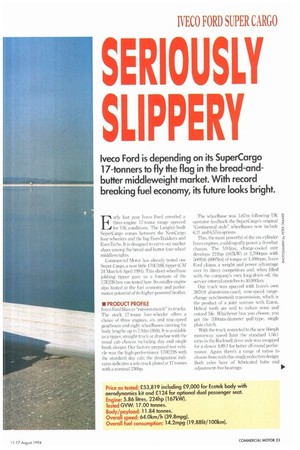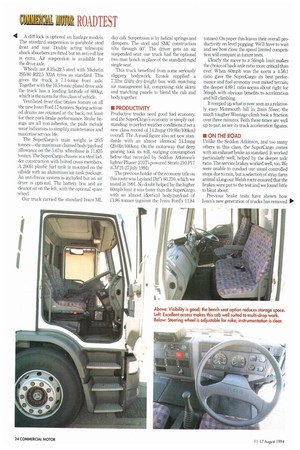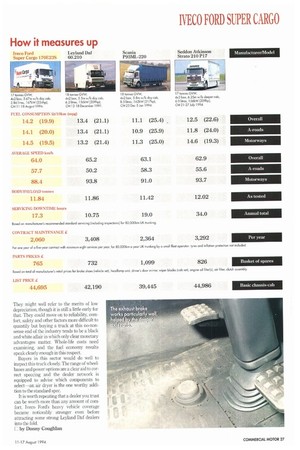SERIOUSLY
Page 23

Page 24

Page 26

Page 27

If you've noticed an error in this article please click here to report it so we can fix it.
SUPPERY FI arly last year Nero Ford unveiled a three-engine 17-tonne range specced
for UK conditions. The Langley-built SuperCargo comes between the NewCargo four-wheelers and the big Eurdirakkers and EuroTec.hs. It is designed to carve out market share among the bread-and-butter four-wheel middleweights.
Commercial Motor has already tested one Super Cargo, a neat little 170E18K tipper (CM 31 March-6 April 1994). This short-wheelbase jobbing tipper gave us a foretaste of the 17E23S box van tested here. Its smaller engine also hinted at the fuel economy and performance potential of its higher-powered brother.
IN PRODUCT PROFILE
Iveco Ford likes to "mission match" its trucks. The stock 17-tonne four-wheeler offers a choice of three engines, six and nine-speed gearboxes and eight wheelbases catering for body lengths up to 7.92m (26ft). it is available as a tipper, straight truck or drawbar with the usual cab choices including day and single bunk sleeper. Our factory-prepared test vehicle was the high-performance 170E23S with the standard day cab; the designation indicates indicates a solo truck plated at 17 tonnes with a nominal 230hp.
The wheelbase was 5.67m following UK operator feedback the SuperCargo original 2 "Continental style" wheelbass now include 6,21 and 6,57m options .
Gs_
This, the most powerful of the six-cylinder 1Iveco engines, could equally power a drawbar chassis. The 5.9-litre, charge-cooled unit develops 224hp (167kW) at 2,700rpm with 5091bft (690Nm) of torque at 1,400rpm. Iveco Ford claims a weight and power advantage over its direct competitors and, when filled with the company's own long-drain oil, the service interval stretches to 40,000km. Our truck was specced with Iveco's own 2870.9 aluminium-cased, nine-speed rangechange synchromesh transmission, which is the product of a joint venture with Eaton. Helical teeth are said to reduce noise and extend life. Whichever box you choose, you get the 330mm-diameter pull-type, single plate clutch.
With the truck restricted to the new 56mph motorway speed limit the standard 4.56:1 ratio in the Rockwell drive axle was swapped for a slower 4.89:1 for better all-round performance. Again there's a range of ratios to choose from with this single reduction design. Both axles have oil lubricated hubs and adjustment-free bearings. A diff-lock is optional on haulage models. The standard suspension is parabolic steel front and rear. Double acting telescopic shock absorbers are fitted but an anti-roll bar is extra. Air suspension is available for the drive axle.
Wheels are 8.25x22.5 steel with Michelin 295/80 R22.5 X=DA tyres as standard. This gives the truck a 7.1-tonne front axle. Together with the 10.5-tonne plated drive axle the truck has a loading latitude of 600kg, which is the norm for this class of vehicle.
Ventilated front disc brakes feature on all the new Iveco Ford 17-tonners. Spring activated drums are retained at the back, not least for their park-brake performance. Brake linings are all non-asbestos; the pads include wear indicators to simplify maintenance and maximise service life.
The SuperCargo's train weight is 20.5 tonnes—the maximum claimed body/payload allowance on the 5.67m wheelbase is 11.835 tonnes. The SuperCargo chassis is a steel ladder construction with bolted cross-members. A 2001it plastic fuel tank is mounted on the offside with an aluminium air-tank package. An anti-freeze system is included but an air dryer is optional. The battery box and air cleaner sit on the left, with the optional spare wheel.
Our truck carried the standard Iveco ML.
day cab. Suspension is by helical springs and dampers. The steel and SMC construction tilts through 600. The driver gets an air suspended seat: our truck had the optional two man bench in place of the standard rigid single seat.
This truck benefited from some seriously slippery bodywork. Ecotek supplied a 7.32m (24ft) dry-freight box with matching air management kit, comprising side skirts and matching panels to blend the cab and body together.
• PRODUCTIVITY Productive trucks need good fuel economy, and the SuperCargo 's economy is simply outstanding: in perfect weather conditions it set a new class record of 14.2mpg (19.91it/100km) overall. The A-road figure also set new standards with an almost identical 14.1mpg (20.01it/100km). On the motorway that deep gearing took its toll, nudging consumption below that recorded by Seddon Atkinson's lighter Phaser 210Ti-powered Strato 210.P17 (CM 21-27 July 1994).
The previous holder of the economy title on this route was Leyland Daf's 60.210, which we tested in 1991. No doubt helped by the higher 60mph limit it was faster than the SuperCargo with an almost identical body/payload of 11.86 tonnes (against the Iveco Ford's 11.84 tonnes). On paper this leaves their overall productivity on level pegging. We'll have to wait and see how close the speed limited competition will compare in future tests Clearly the move to a 56mph limit makes the choice of back-axle ratio more critical than ever. When 60mph was the norm a 4.56:1 ratio gave the SuperCargo its best performance and fuel economy over mixed terrain; the deeper 4.89:1 ratio seems about right for 56mph with obvious benefits to acceleration and hill climbing.
It romped up what is now seen as a relatively easy Monmouth hill in 2min 55sec; the much tougher Wantage climb took a fraction over three minutes. Both these times are well up to par, as are its track acceleration figures.
• ON THE ROAD Unlike the Seddon Atkinson, and too many others in this class, the SuperCargo comes with an exhaust brake as standard. It worked particularly well, helped by the deeper axle ratio. The service brakes worked well, too. We were unable to conduct our usual controlled stops due to rain, but a selection of stray farm animal along our Welsh route ensured that the brakes were put to the test and we found little to bleat about.
Previous brake tests have shown how Iveco's new generation of trucks has removed the delay inherent in its older brake designs.
Interior noise is much improved too. The NewCargo and SuperCargo have both recorded some of our lowest in-cab noise figures to date and this is to be applauded: the effects of noise on driver fatigue cannot be overestimated. At least part of the credit for this improvement should go to a gearstick that doesn't rattle about in idle moments; that said, this is not the smoothest gearchange we've ever experienced.
The ride is firm, even bumpy on poor road surfaces, but cab roll is well controlled. The well balanced ZF steering system provides competent handling, allowing the truck to be pushed hard through corners with confidence. The effective braking and power, with a firm ride and responsive handling makes the SuperCargo a pleasure to drive.
• CAB COMFORT This cab is among the best non-sleeper designs in the business. Excellent access and good visibility make it well suited to distribution work. There are some pleasingly simple items, too, such as the big red hazard warning switch. These things come into their own when you're the relief driver just assigned an unfamiliar vehicle in a strange depot on a dark, wet night. We liked the strong interior lighting and demister system, too.
The well-suspended cab has a driver's air seat as standard with a steering column which is adjustable for rake and an electrically powered nearside window. Integral seatbelts are a must for trucks and the Iveco/Isringhausen solution is a good one. We also appreciated the electrically heated mirrors and clear instrumentation. We still don't like the confusing twin stalk control system and the distracting radio position, but at least early problems with build quality have been addressed, leaving fewer rattles.
Drivers can never get enough storage. The SuperCargo cab provides a large number of compartments, albeit small ones. The multiple door pockets work very well, as does the rear bulkhead tray but the optional bench seat makes behind-the-seat storage awkward.
• SUMMARY The best of the Iveco Ford introductory offers may be gone, but this is still a good time to buy. At £44,695 the Super Cargo is not the cheapest truck in its class: the Scania with its 7.5-tonne front axle as standard comes in at just .£39,445. The (previously) record breaking Leyland Daf also looks a good bet at 1:42,190 with the best parts prices to boot. Body/payload potential, cost of ownership and dealer quality must all be taken into consideration, too, of course. Contract maintenance is increasingly popular, and our guide gives some food for thought. With its extended oil change period the Iveco Ford's annual contract cost becomes attractive.
The Super Cargo's body/payload allowance sets no new records, but is up there with the market leaders for any given wheelbase. Ironically the Straw, from fellow Iveco Group member Seddon Atkinson, remains embarrassingly good on payload— Iveco Ford salesmen will need to be ready with their excuses. They might well refer to the merits of low depreciation, though it is still a little early for that. They could move on to reliability, comfort, safety and other factors more difficult to quantify but buying a truck at this no-nonsense end of the industry tends to be a black and white affair in which only clear monetary advantages matter. Whole-life costs need examining, and the fuel economy results speak clearly enough in this respect.
Buyers in this sector would do well to inspect this truck closely. The range of wheelbases and power options are a clear aid to correct speccing and the dealer network is equipped to advise which components to select-an air dryer is the one worthy addition to the standard spec.
It is worth repeating that a dealer you trust can be worth more than any amount of comfort. Iveco Ford's heavy vehicle coverage became noticeably stronger even before attracting some strong Leyland Daf dealers into the fold.
by Danny Coughlan














































































